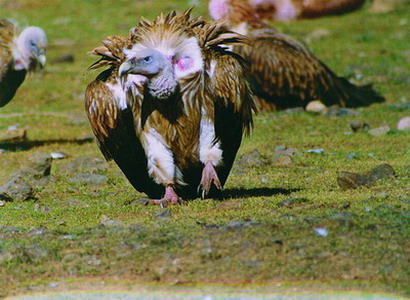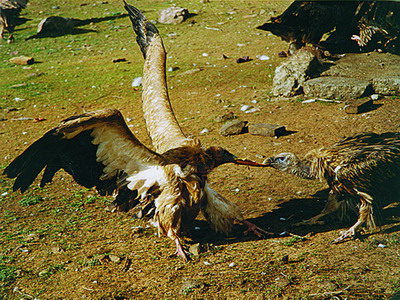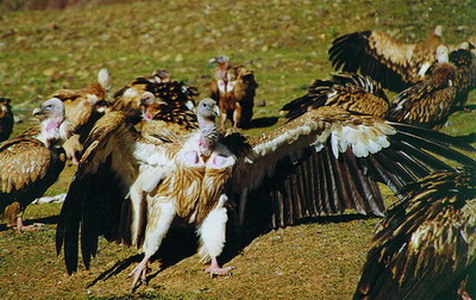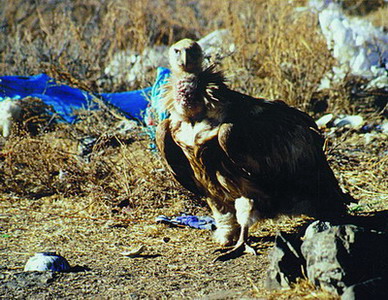In a Tibetan valley, before the sun rises, a corpse tied in a fetal position is laid on a large rock on a mountainside. Someone is burning a fire with cypress branches and Indian azalea branches, onto which zanba (roasted highland barley) is sprinkled, and the smoke curls upwards.
A very strange odor soon begins to spread across the valley.

Within 20 minutes, a black dot emerges from before the rising sun and begins to fly towards the smoke; one dot, two, three...
Gradually, the first dot assumes the shape of a bird; with streamlined body, beautiful stretching and seldom flapping wings, it glides slowly downwards.
Cinereous vulture, which is called “Kor” or “Korcha” in Tibetan, can be seen in various Tibetan-inhabited areas.
Those currently found in Tibet are only in one color hemp grey. It is said there are white cinereous vultures, but they have rarely been seen. According to old people, in the early 1930s and 1940s there were many white cinereous vultures and they were commonly seen at each celestial burial ground. An old celestial burial master named Cewang said that he had adopted a young, wounded white cinereous vulture when he was young and gave it the name of Cering.
In the eyes of many Tibetans, white cinereous vultures are “deities” who have descended to the world as messengers of the founder of Buddhism If a white cinereous vulture appears in celestial burial of a dead person, that is considered a great spiritual favor on the deceased bringing blessings on all the descendants.
Zhigungti Celestial Burial Ground is the largest of its kind in Tibet. Each day, families send their deceased to embark on a journey to the “Pure Land”. Besides its long history and typically mysterious legends, the most widely spread story is that the head of the cinereous vultures came from the Indian Siba Celestial Burial Ground.
Tari Village of Renbu County presents a picturesque scene, being surrounded by mountains. Due to lack of highways and electric power, the villagers start work at sunrise and return home at sunset. When people and livestock die, the Yarlung Zangbo River is the final resting place. As told by the villagers, celestial burial was still popular here until 20 years ago. Because a young cowherd hurt a cinereous vulture by mistake when throwing stones to drive his sheep, the birds no longer appear at the Tari Celestial Burial Ground. Subsequently, the child cowherd developed a rare disease that disabled both his arms. Another story says that the daughter of a celestial burial master died and he carried the corpse secretly to the burial ground. This so offended the cinereous vultures that they disappeared.
In the nunnery of Tari Village, the nuns hold a Grand Summons Ceremony on the 15th day of the fourth Tibetan month each year. They all face the celestial burial ground and pray by reciting sutras, hoping the holy vulturesto appear as soon as possible.
Holy Vultures

Holy vultures, namely cinereous vulture, are normally large. Facing possible danger, they often shrink their necks and their eyes stare coldly. They like squatting on rocks facing the sun, so that the people call them “dog-headed vultures” or mountain-seated vultures. Their coloring is hemp grey all over the body, with dark brown quill-coverts on top of the head; the exposed part of the neck appears pinkish, sparsely covered with quill-coverts. The base of its neck is covered with thick quill-coverts radiating around the neck. Light brown lines are seen along the edges of the plumage and the wings and tail are dark brown. The lower body appears yellowish brown with light-colored longitudinal lines. The legs are bulky and strong. The part below knees is exposed in bluish dark color. The claws are sharp, and, when tearing at food, the bird is able to stand to one leg and use the other claw to rip off strips of meat.
The cinereous vulture is a bird of prey without the ability of eagles to capture live food as its claws are not sharp enough. It can occasionally capture a hare, but this is not enough to sustain life. When it is hungry, it has to feed off the corpses of animals. However, while eating the rotten meat of the bowels, the neck feathers inevitably become contaminated and they are hard to clean. With the passage of time, a few off-white short quill-coverts are left on the head and neck of a cinereous vulture, resulting in the familiar bald appearance.
A grown-up cinereous vulture and a newly grown young vulture are not much different in size, but they are definitely different in feather color.
A grown-up vulture is covered completely with dark brown quill-coverts from its forehead to the back of its head, and these are especially dense in the rear; the exposed part of the neck is livid blue with a pinkish hue. The plumes are light brown; the overlapping feathers on the back, shoulder, waist and tail are all dark brown; a circularly exposed skin on both wings close to shoulder blade looks like two eyes from afar. The overlapping feathers of wings and secondary and third-layer remexes are all dark brown. The primary remexes are dingy brown; the tail feathers appear dark brown; the feather axis shows a dingy brown hue. The lower body is dark brown; hair-like quill-coverts are densely distributed over the breast, with a bunch of conspicuously loose, spear-like long feathers on both sides. Slightly colored longitudinal lines can be seen on the breast and stomach feathers; the overlapping feathers around its vent and under the tail are brownish white.
In appearance, it is difficult to identify the males and females in a group. The individual size of a female vulture is slightly larger than a male. Young birds that follow their parents have a size close to their parents, but the quill-coverts on their heads appear black instead of dark brown. The rear part of the head is dark brown, but its fore neck contains black stripes. The complete upper body appears brown, but it is denser than a grown-up bird. The circular exposed parts on the shoulder blades are not obvious. The lower body is black.
Nests of cinereous vulture are generally located on cliffs or tall trees using dry branches, in which a layer of dry hay has been spread. In Tibet, cinereous vultures are resident birds. In the breeding season, they usually rebuild the nests of previous years. A nest can be used for several years in this way. Cinereous vultures do not like living in groups, and it is rare to see two or three nests together. A boy called Puncog in Nyangri Village often goes herding on the slopes of Polungka. He says nests built by cinereous vultures can be found on the cliffs and he has climbed there to steal eggs, but you to be sure that the adult vultures are not around. He also says that cinereous vultures that have hatching eggs are dangerous and will attack any strangers approaching their nests.
Once grown-up cinereous vultures form a family, the couple will live together forever. The reproduction period is earlier than other birds. In early March of each year, they lay eggs one at a time, and it is rare to two eggs in a nest. They appear grayish white, with dark stripes and dots on the shells, and are slightly larger than the eggs of domestic geese. The male and the female sit on egg in turn, while the other is out hunting for food. The hatching takes about 55 days. Nestlings grow up slowly. They have coal grey fine quill-coverts distributed densely all over the body, with yellow stripes on the back of the exposed necks. They generally start to fly in early August.

As explained by some celestial burial masters, parent cinereous vultures can be easily identified at the celestial burial ground, as they look busier than others. They sometimes make several rounds to take food back for the nestlings.
The feathers of a young cinereous vulture will not be completely replaced until the following year. After this feather replacement they vary little in size from grown-up birds. Even some experienced celestial burial masters can hardly distinguish them.
King of Cinereous Vultures
Cinereous vultures are extremely mild. Eating dead bodies is their need for survival. When they are very hungry, they may occasionally capture some small animals such as hare and rat as previously noted, but attacking domestic animals or even man is unheard of. They prefer to get close to man, and, as long as they are not hurt, their behavior is similar to domestic geese.
Gangzhub, at 88, is the oldest of the traditional celestial burial masters. Due to health problem, he quit his job in 1992. During a period of 62 years, from when he was 14 until retirement, he worked with cinereous vultures nearly each day. He is deeply impressed by the one called Puncog whom he got to know at the Zhigungti Celestial Burial Ground and even remembers that he was 29 at the time. Puncog may be nothing among the cinereous vultures at the Zhigungti Celestial Burial Ground, but he is kingon the territory of the Deqen Celestial Burial Ground.
Puncog worked well with Gangzhub once it became familiar with him. Generally, when a celestial burial master works, impatient vultures often rush to snatch the food, which affects the proceeding. When Gangzhub was working, he would call Puncog and the bird would waddle forward and spread its wings to ward off other incursions by other vultures. Gangzhub gave Puncog a piece of meat first, and the other birds then began to rush for food after seeing that Puncog was eating.
Do these special cinereous vulture kings exist or not If they do, what are their stories
I have interviewed six celestial burial masters as young as 25 and as old as 88, and they all insist that such kings do exist. The old celestial burial masters have seen them, such as Puncog which was not only familiar to Gangzhub but also was known to the old celestial burial master Lhogar and the Deqen master Cewang of the Sera Monastery.

However, they should not exist according to understood habits of cinereous vultures, so I undertook a series of investigations about Puncog and the golden cinereous vulture kingof the Dequen Celestial Burial Ground.
Gangzhub says that, before liberation, celestial burial masters were at the bottom among all the professions. Even their children looked down upon their fathers because of their profession. To escape from the biased public view, many celestial burial masters built small cottages as their habitat beside the celestial burial grounds. However, compared with common people, their lives were better as they had meat and other food. Therefore, some cinereous vultures that had left their arrival somewhat late would get some meat bones and meat dumplings when the celestial burial masters were eating.
But this only occurred for one or two birds that were named after some bodily peculiarity such as the lameand the one-eyed... Those without physiological characteristics would be named “Shida”, “Benba” and “Chigyia”, which were the names of people, as was Puncog. With the passage of time, a bird could understand some instructions from a master, and they would receive some special care as a result. For example, after the preparatory work had been done, they were fed first. These cinereous vultures that had close relationships with celestial burial masters thus eventually became the aforementioned kings.

In recent years, I have visited eight celestial burial grounds and watched not less than 20 complete celestial burial processes. Watching cinereous vultures from a short distance, I tried to find such a king but unfortunately was never successful. For example, I never witnessed the scene that other cinereous vultures dare not eat before the king had begun feasting. So long as a celestial burial master has finished his work, a group of cinereous vultures will rush forward. I remember well a time in Zhigungti, when a corpse was carried toward to the celestial burial ground, and the cinereous vultures lying quietly on the nearby grassland to enjoy sunlight became restive by extending their necks to look afar. According to procedure of Zhigungti, the corpse is placed on an “altar” followed by the reciting of sutras for about two minutes; a celestial burial master unfolds the funeral shroud and begins cutting the muscles of the corpse in different areas, and then the stomach. Finishing all of this work, he backs away and calls the vultures to come forth. But the scene of that day was far removed from the normal procedure. When the corpse was placed on the “altar” and the celestial burial master untied a corner of shroud, an unpleasant odor spread in the air and the vultures rushed forward. Two relatives held large sticks to drive them away, but even as one bird was driven off another would attack. The shouts of the celestial burial master had no effect. Those present could not help but back off and let the vultures feast. At the moment, however, a very humanistic thing occurred. One cinereous vulture immersed its head and body into the abdominal cavity of the corpse. The celestial burial master perhaps thought this was ridiculous and pulled the bird out by its tail and threw it on the grassland. It still attempted to go back inside. The celestial burial master simply held it, removed the blood off its head, tapped its head several times, and threw it outside.
Concerning the story of the vulture king the burial master Lhogar, who is 76 and still working in the Sera monastery, hits the mark with a single comment. Current celestial burial masters of the young generation make more money and friends and possess private cars. They have no patience with making friends with cinereous vultures and teaching them some rules. The masters trained the Kings Without training, the rules certainly do not exist any more, thus there are no Kings Cinereous Vultures Today
Cinereous vultures have a height of 0.8-1 meters. Their wingspan is 1.8-2 meters. They have round eyes and exposed skin on the neck, and squat on large rocks facing sun or high mountain slopes with white feathers quivering slightly...
Tibetans respect them, which is shown in a variety of forms by carving their image on Mani stones, painting them on doors, printing them on flying sutra streamers and drawing them on walls of monasteries...
During interviews for this article, I frequently saw some scenes of Tibetans taking care of cinereous vultures.
In Qamdo County, a person with esophageal cancer stayed in hospital for a long time. When he died, he was already very skinny. His relatives bought lots of beef and sent it together with the corpse to the celestial burial ground, explaining that the dead person was too skinny to feed the holy vulturesalone. They would soon take away the soul of the dead after they were glutted. I do not want to spend more ink on such rootless things, but the manner of fearing that the cinereous vultures are not fed enough and mixing corpse with beef to feed them is somewhat moving!
In the eyes of ordinary people, cinereous vultures are hard to get along with, but in eyes of celestial burial masters, they are friends, partners, or even...colleagues.
Raodain has been engaged in the job for 30 years. Over that time, the bulk of his contacts have been with cinereous vultures. He says they are like children that I have raised. The absence of them from my eyes for even one day makes me feel at a loss and restless. I take care of them everyday. I see them grow up. They bring young vultures to the celestial burial ground soon after they hatch. The young ones grow up day-by-day and the old ones age and disappear suddenly in a day. I am aging year by year too! The young celestial burial master Dawa very much favors a bird called the lameat the Sera Monastery Celestial Burial Ground. He says it originally had good legs. But, one day in mid-June of last year it was found crippled in one leg, probably caused by a trapper. I initially pitied it and gave it special care in feeding. Little did I think that we would become more and more attached day by day. At the end of a celestial burial, other vultures fly away, but the lamestill follows Dawa when he is cleaning the burial ground and is reluctant to leave.
Each summer, some young vultures will appear on different celestial burial grounds following their parents. Although they are as big as their parents, their innocence can be identified from their bright feather colors and quickly moving eyes. I was lucky to see such a scene.
As told by celestial burial masters, the number of cinereous vultures has seen a significant rise in the past two years. Before 1995, the Polungka celestial burial ground had only 170-odd birds, the Sera Monastery celestial burial ground less than 100, Zhigungti Celestial Burial Ground more than 300, and Deqen celestial burial ground more than 80. Now, Polungka owns about 350 vultures, Sera Monastery more than 130, Zhigungti, the most with 556, and Deqen 122.
Although cinereous vultures eat corpses and have certain immune ability against some viruses and bacteria, there is always something against which they cannot defend. The year before last, a person living near Lhasa Cement Factory died from eating a virulent rat killer. The dead person was sent to Polungka celestial burial ground and more than 100 vultures died from the poison. This accident greatly shocked the common people and celestial burial masters.
In fact, each conscientious celestial burial master will ask relatives of the dead for the causes of death. In case of infectious diseases or poisoning that may threaten the lives of cinereous vultures, the corpses certainly will be rejected. This has almost become an unwritten rule for celestial burial masters.
In the eyes of the Tibetan people, cinereous vultures are kings among birds and they are too holy to be violated. Nobody ever hurts them purposely. Thus, cinereous vultures can live freely on this land.
